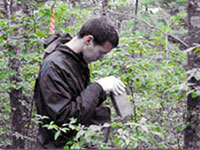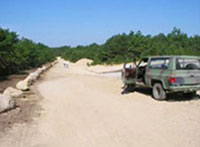Integrated Training Area Management (ITAM)
 The Integrated Training Area Management (ITAM) Program is responsible for maintaining the land to help the Army to meet its training requirements. This requires understanding and balancing Army Training requirements and land management practices. The Integrated Training Area Management Program (ITAM) is the U.S. Army standard for sustaining the capability of installation land units to support their military training missions by achieving the following goals:
The Integrated Training Area Management (ITAM) Program is responsible for maintaining the land to help the Army to meet its training requirements. This requires understanding and balancing Army Training requirements and land management practices. The Integrated Training Area Management Program (ITAM) is the U.S. Army standard for sustaining the capability of installation land units to support their military training missions by achieving the following goals:
- to integrate environmental planning procedures into all operations
- to protect natural and cultural resources
- to ensure compliance with existing statutory regulations
- to prevent future pollution and reduce hazardous waste and toxic releases (This final goal is coordinated through the Camp Edwards Environmental Manger and Hazardous Waste Coordinator. References: JBCC Groundwater Protection Policy, October 1, 2003, Camp Edwards Integrated Contingency Plan and the Hazardous Materials and Waste Management Plans.)
The ITAM Program relies on its four components and an integrated management from HQDA, MACOM, and installations to accomplish its mission. The four components are Range and Training Land Assessment (RTLA); Training Requirements Integration (TRI); Land Rehabilitation and Maintenance (LRAM); and Sustainable Range Awareness (SRA). These components combine to provide the means to understand how the Army's training requirements impact land management practices, what the impact of training is on the land, how to mitigate and repair the impact, and communicate the ITAM message to soldiers and the public. Geographic Information Systems (GIS) is a foundational support element that provides locational information that assists land managers in making their decisions.
Range and Training Land Assessments (RTLA):
The RTLA program inventories and monitors natural resource conditions and manages and analyzes natural resource information. Results are pertinent to management of training and testing lands from training area to installation scales and provides input to decisions that promote sustained and multiple uses on military lands. The RTLA program evaluates relationships between land use and condition through the collection of physical and biological resource data. Some RTLA projects are long term, while others are relatively short. Key to RTLA success is the evaluation and analysis of collected data.
Training Requirements Integration (TRI):
TRI is the component of the ITAM Program that provides a decision support procedure that integrates training requirements with land management, training management, and natural and cultural resources management processes and data derived from RTLA and Army Conservation Program components.
Land Rehabilitation and Maintenance (LRAM):
LRAM is the component of the ITAM Program that provides a preventive and corrective land rehabilitation and maintenance procedure to reduce the long-term impacts of training and testing on an installation. It includes training area redesign and/or reconfiguration to meet training requirements.
Sustainable Range Awareness (SRA):
Sustainable Range Awareness is the component of the ITAM Program that provides a proactive means to develop and distribute educational materials to users of range and training land assets. Materials relate procedures that reduce the potential for inflicting avoidable impacts on range and training land assets, including the local natural and cultural resources. ITAM SRA addresses specific environmental sensitivities at the installation level, to inform land users of restrictions and activities to avoid so as to prevent damage to natural and cultural resources.
Together, the ITAM Program and the Natural Resource Management Program ensure sustainable use of training lands as well as taking into consideration the surrounding environment and public concern.
The National Guard Bureau (NGB) and Commonwealth of Massachusetts, State Military Department (MAARNG) have made a commitment to implement the ITAM program at Camp Edwards. ITAM at Camp Edwards was formally initiated with the start of the Land Condition Trend Analysis (now the RTLA program) Program in 1993.
 The ITAM Program at Camp Edwards is administered by the Camp Edwards Natural Resources Office with cooperation and support from Operations and Range Control at Camp Edwards. The RTLA portion of the ITAM Program is carried out by the seasonal and permanent staff of the Camp Edwards Natural Resource Office. LRAM Projects are initiated by the Camp Edwards Natural Resource Office, with most of the work conducted by the Roads and Grounds crew within the Camp Edwards Division of Facilities Engineering. TRI initiatives are coordinated between the Camp Edwards Natural Resource Office, The Environmental & Readiness Center , Range Control, and trainers. The SRA portion of the ITAM Program is conducted by the Camp Edwards Natural Resource Office with an emphasis not only on the soldiers that train at Camp Edwards, but also people and organizations outside the MAARNG (e.g., the public, local school groups).
The ITAM Program at Camp Edwards is administered by the Camp Edwards Natural Resources Office with cooperation and support from Operations and Range Control at Camp Edwards. The RTLA portion of the ITAM Program is carried out by the seasonal and permanent staff of the Camp Edwards Natural Resource Office. LRAM Projects are initiated by the Camp Edwards Natural Resource Office, with most of the work conducted by the Roads and Grounds crew within the Camp Edwards Division of Facilities Engineering. TRI initiatives are coordinated between the Camp Edwards Natural Resource Office, The Environmental & Readiness Center , Range Control, and trainers. The SRA portion of the ITAM Program is conducted by the Camp Edwards Natural Resource Office with an emphasis not only on the soldiers that train at Camp Edwards, but also people and organizations outside the MAARNG (e.g., the public, local school groups).
For further information regarding the ITAM Program see the Camp Edwards Training Site Integrated Natural Resource Management Plan.